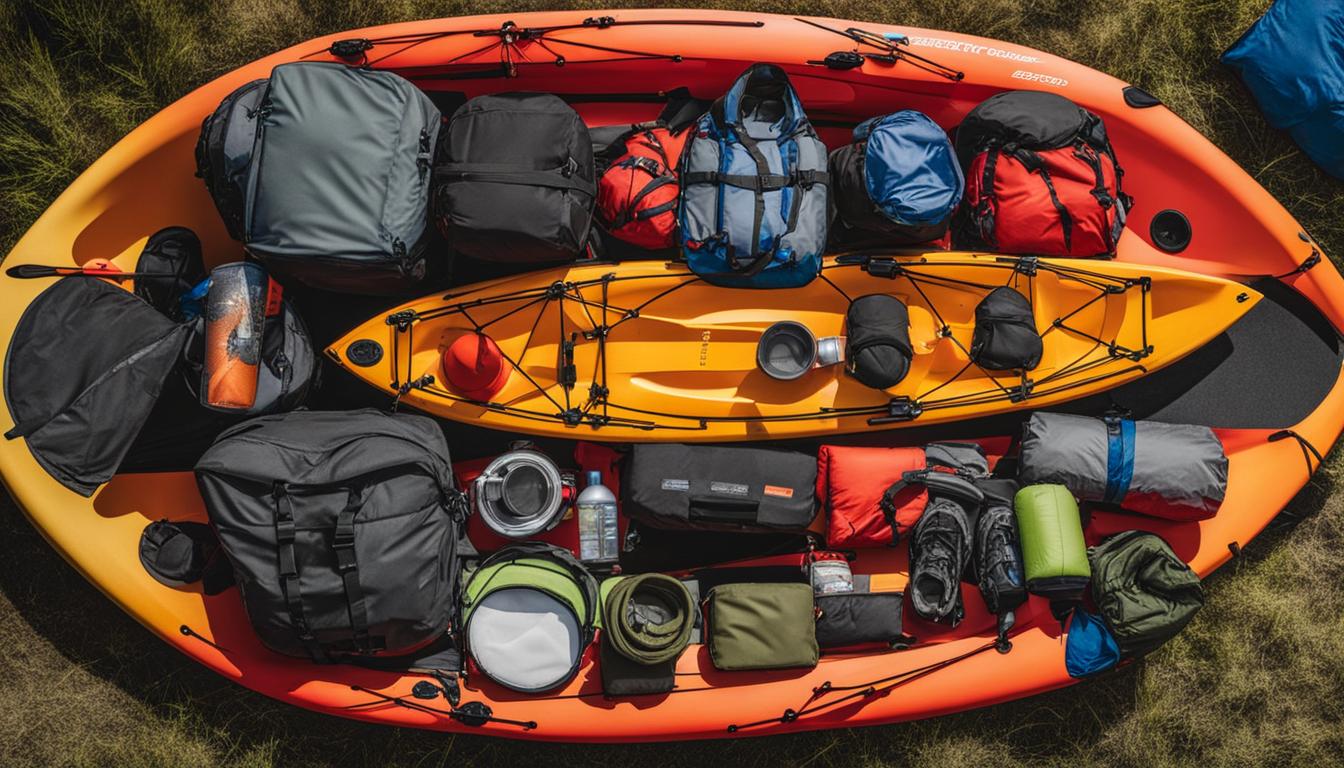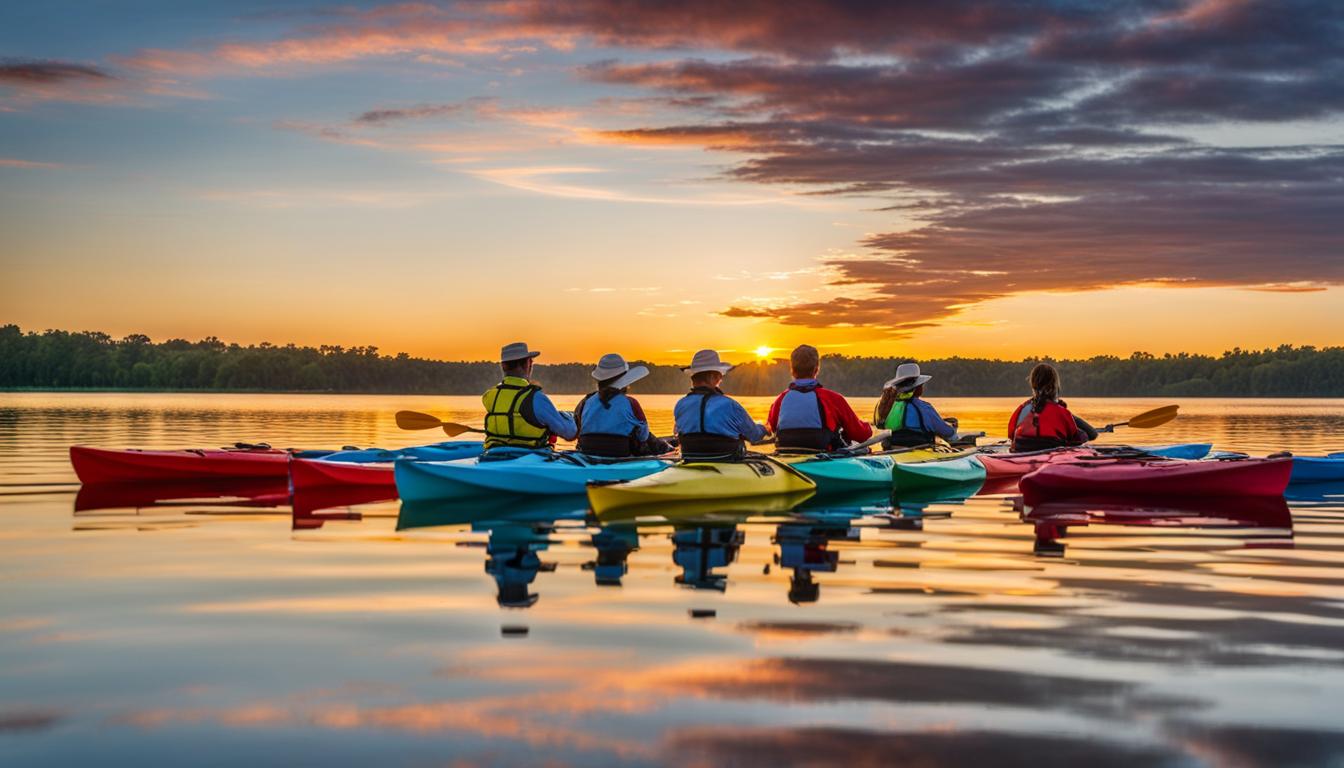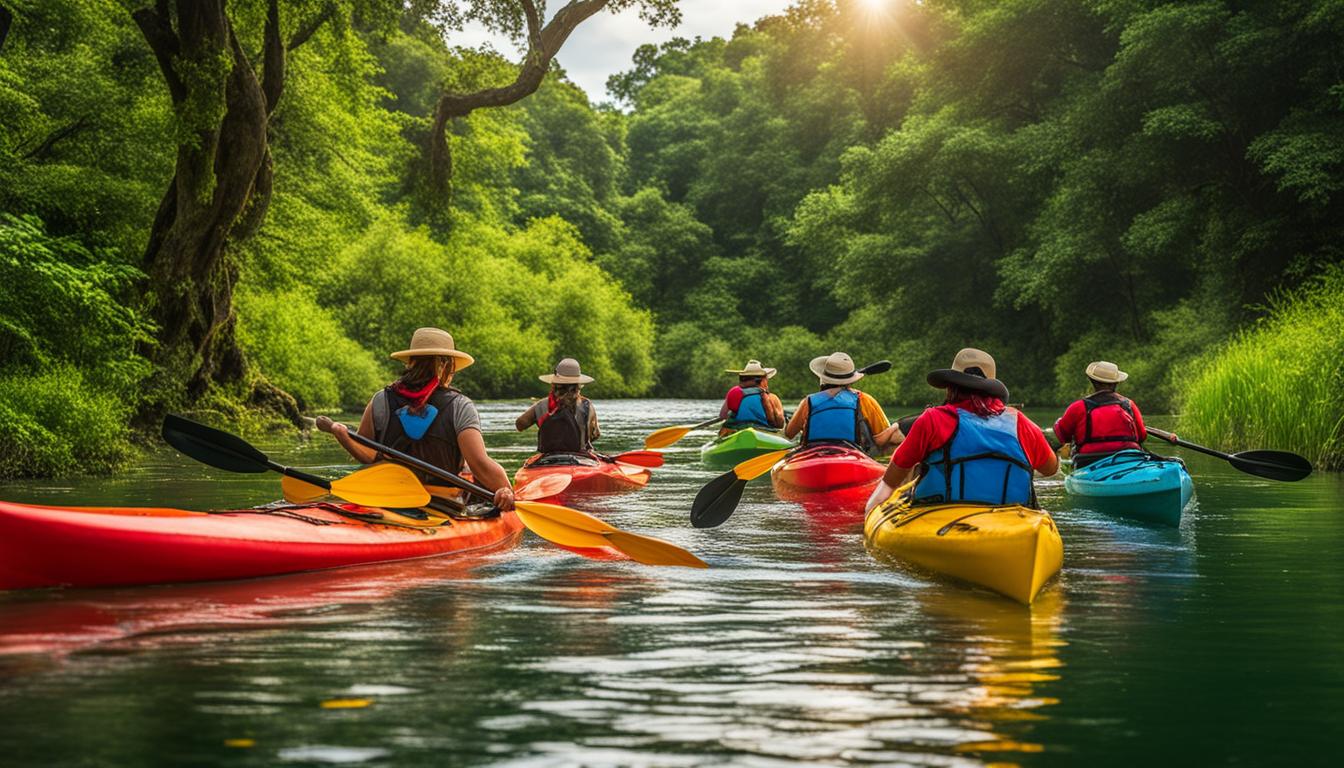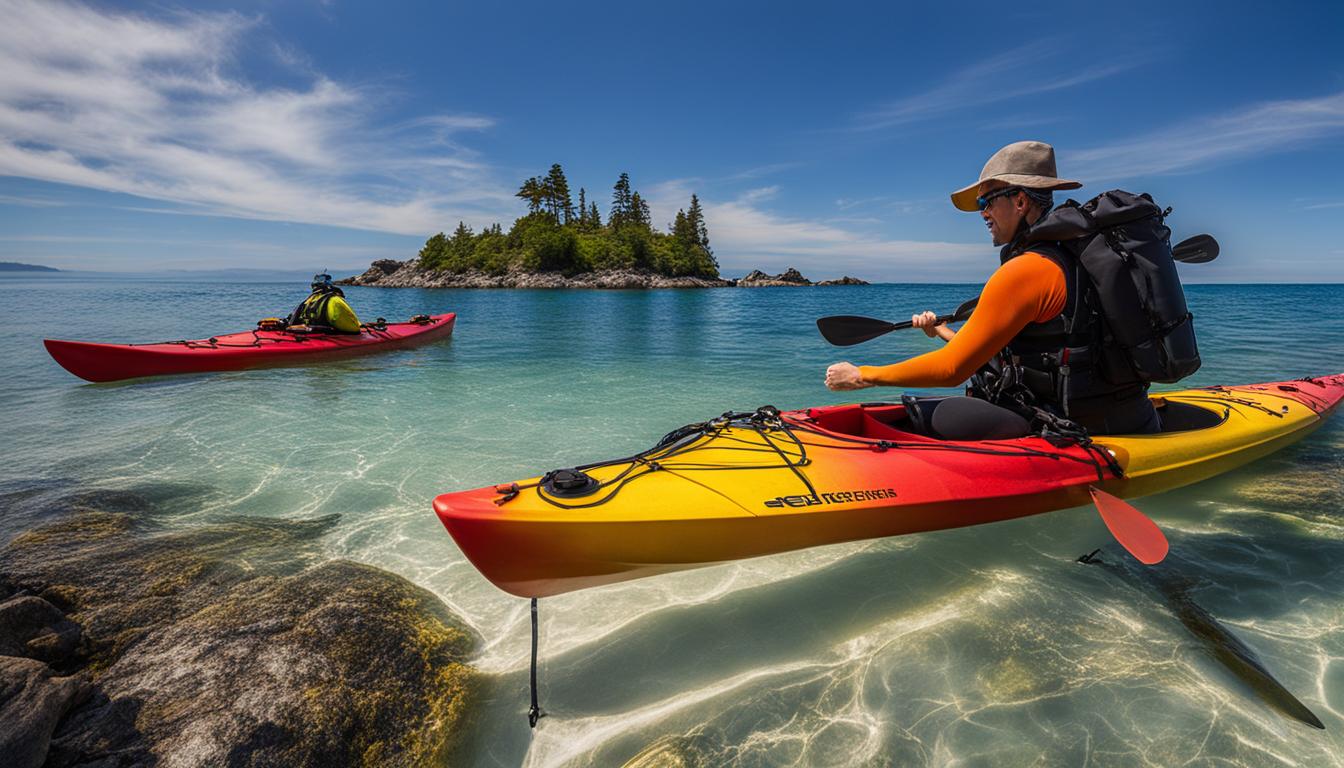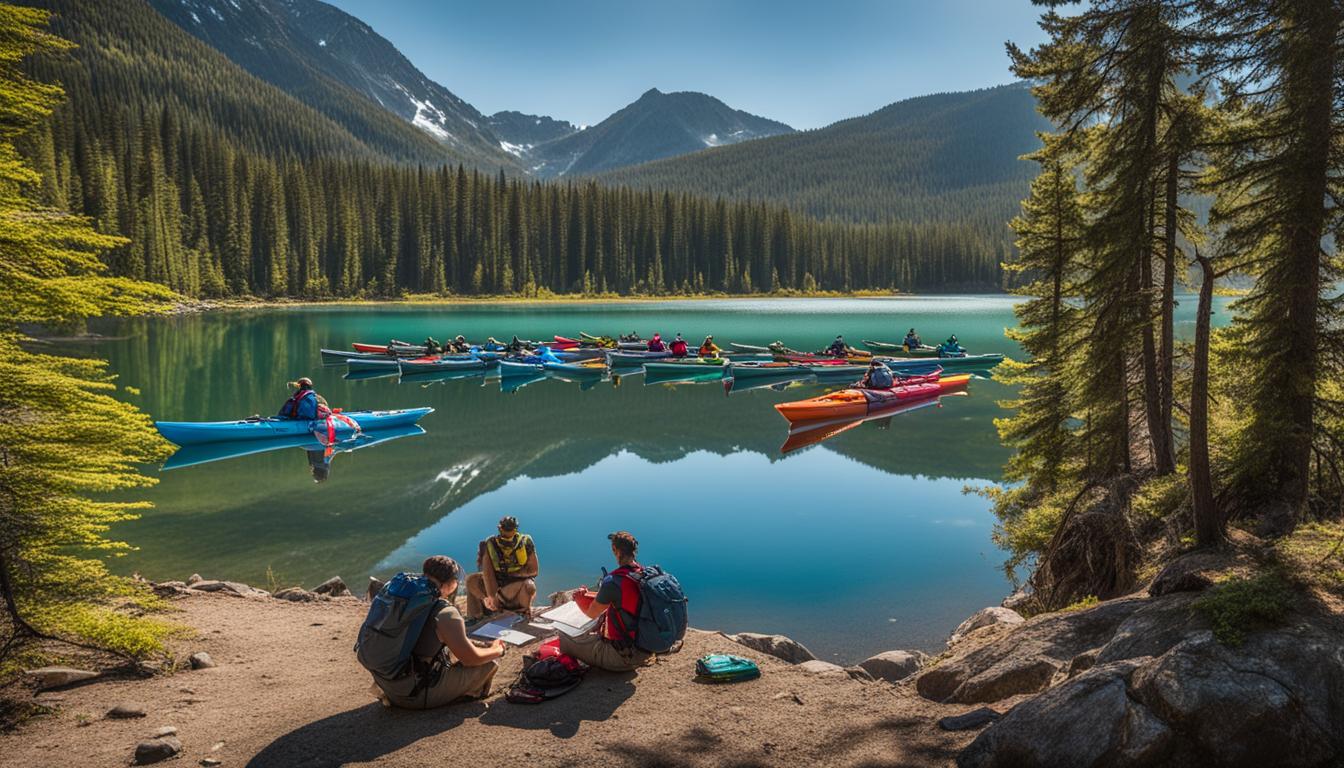When preparing for a kayak camping trip, it’s important to pack efficiently to optimize space and ensure stability on the water. Pack light and use smaller drybags that can easily fit into the oddly-shaped interior of most kayaks. Color code and label your bags for easy organization. Pack heavier items near the middle of the kayak and lighter, bulky items towards the ends to maintain balance. Test-pack your kayak before your trip to ensure everything fits. Remember, the goal of kayak camping is to get away from it all, so prioritize necessary items over unnecessary ones.
- Optimize space and stability by packing light and using smaller drybags.
- Color code and label your bags for easy organization.
- Distribute weight properly by placing heavier items in the middle and lighter items towards the ends of the kayak.
- Test-pack your kayak before your trip to ensure everything fits properly.
- Prioritize necessary items over unnecessary ones to make the most of your kayak camping experience.
Size Matters: Choosing the Right Drybags for Efficient Packing
When it comes to packing for a kayak camping adventure, choosing the right drybags is crucial for efficient and space-saving packing. Opting for smaller drybags that can adapt to the interior of your kayak is key. These smaller bags can easily fit into the oddly-shaped compartments of most kayaks, allowing you to utilize every inch of available space. Lightweight materials like nylon or polyester with an internal rubberized waterproof coating are preferred, as they can slide past each other, making packing and unpacking a breeze.
“Using smaller drybags allows you to utilize every inch of available space in your kayak, making it easier to pack efficiently for your camping adventure.” – Experienced Kayak Camper
When selecting drybags, squeezing out as much air as possible before sealing each bag is essential. This helps conserve space and ensures a snug fit inside your kayak. Additionally, consider color coding or labeling your drybags to further organize your gear. This will make it easier to locate specific items without having to rummage through all your bags.
To give you an idea of how to choose the right drybags for efficient packing, here’s a table showcasing the different sizes and capacities available:
| Drybag Size | Capacity |
|---|---|
| Small | 10-15 liters |
| Medium | 20-25 liters |
| Large | 30-35 liters |
By choosing the right drybags and following efficient packing strategies, you can optimize space, maximize organization, and ensure a hassle-free kayak camping experience.
Achieving Balance: Proper Weight Distribution in Your Kayak
When organizing your gear for a kayak trip, one important consideration is achieving proper weight distribution in your kayak. This plays a crucial role in maintaining stability and balance while paddling. By strategically packing your gear, you can maximize space and ensure a smooth and enjoyable kayaking experience.
Pack Heavier Items Near the Middle
To achieve proper weight distribution, it is recommended to pack heavier items near the middle of the kayak. This includes essentials like food, water, and cooking equipment. Placing these items just behind the rear bulkhead helps maintain stability and prevents your kayak from becoming back-heavy. By keeping the weight centered, you’ll have better control and maneuverability on the water.
Lighter, Bulky Items towards the Ends
On the other hand, lighter, bulky items such as sleeping bags and clothing should be packed towards the ends of the kayak. This helps maintain balance and prevents the kayak from becoming front-heavy. By distributing the weight evenly along the length of the kayak, you’ll have a smoother and more comfortable paddling experience.
Test the Weight Distribution
Before embarking on your kayak trip, it’s essential to test the weight distribution in your kayak. Load it up with all your gear and take it for a test paddle in calm waters. Pay attention to how the kayak feels and make adjustments as necessary. By testing the weight distribution beforehand, you can fine-tune your packing and ensure optimal stability on the water.
By properly organizing and distributing the weight of your gear in your kayak, you can maximize space, maintain balance, and enhance your overall kayaking experience. Remember to pack heavier items near the middle, lighter items towards the ends, and always test the weight distribution before hitting the water. With these tips in mind, you’ll be well-prepared for a successful and enjoyable kayak trip.
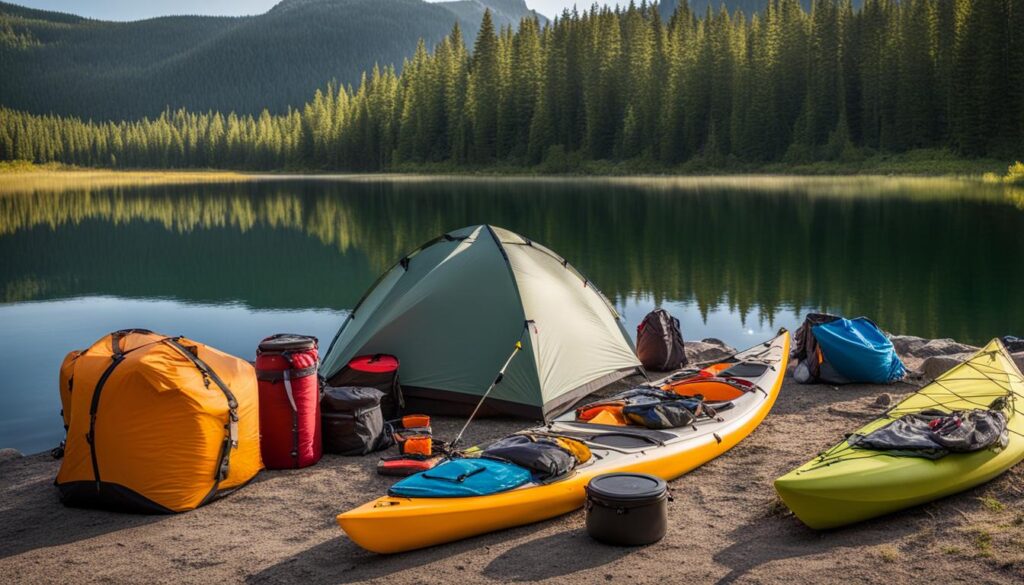
| Benefits of Proper Weight Distribution | Packing Tips for Weight Distribution |
|---|---|
| 1. Improved stability and balance | – Pack heavier items near the middle |
| 2. Better control and maneuverability | – Pack lighter, bulky items towards the ends |
| 3. Enhanced comfort during paddling | – Test the weight distribution before your trip |
| 4. Minimized risk of capsizing |
Essential Gear for a Well-Packed Kayak Camping Adventure
When it comes to kayak camping, having the right gear is essential for a successful and enjoyable trip. Here is a comprehensive list of essential items to pack for your adventure:
Kayak and Necessary Equipment
Of course, the first item on your packing list should be your kayak itself. Make sure it is in good condition and properly equipped with all the necessary gear, including a deck compass, paddle with leash, and a spare paddle. Don’t forget to also pack a personal flotation device (PFD) and all the necessary safety gear.
Essential Safety Equipment
Safety should always be a priority when venturing out on the water. Be sure to pack a spray skirt, bilge pump, and paddle float to handle any unexpected situations. Additionally, include items like signal flares, an air horn, and a first aid kit to ensure you are prepared for any emergencies that may arise.
Navigation Tools and Communication
When exploring new areas, it’s important to have the right tools for navigation. Bring a mapcase with maps and guidebook excerpts to help you navigate your way. Consider packing a hydration pack and tow belt for added convenience. Don’t forget to include a deck bag for easy access to items like binoculars, spare camera batteries, snacks, and a VHF marine radio protocol cheat sheet.
Other Essential Items
Finally, make sure to pack other essential items such as a headlamp, photo tripod, and a latrine kit. These items can greatly enhance your camping experience and make your time on the water more enjoyable.
Remember, the key to efficient packing for kayak camping is to prioritize the essentials while minimizing unnecessary items. By following this guide and ensuring you have all the necessary gear, you can have a well-packed kayak camping adventure.

Conclusion
Packing efficiently for your kayak camping adventure is crucial to ensure a well-organized and enjoyable trip. By following these tips and strategies, you can optimize space and maintain stability on the water.
First and foremost, choose the right drybags for your gear. Opt for smaller bags that can easily fit into the interior of your kayak. Lightweight nylon or polyester bags with a waterproof coating are ideal for efficient packing. Remember to squeeze out excess air to save space.
Proper weight distribution is essential for maintaining balance in your kayak. Pack heavier items near the middle of the kayak, close to the rear bulkhead, and place lighter, bulkier items towards the ends. Testing the weight distribution before your trip will ensure stability and a smooth ride.
Lastly, make sure you pack all the essential gear for your kayak camping adventure. From your kayak and safety equipment to navigation tools and personal items, having everything you need is key. Prioritize necessary items over unnecessary ones and consider using color coding or labeling for easy organization.
By following these tips and packing efficiently, you’ll be well-prepared for your kayak camping adventure and can make the most of your time on the water. Enjoy the freedom and serenity of the great outdoors!
FAQ
How should I pack my kayak for a camping trip?
When packing your kayak for a camping trip, it’s important to pack efficiently to optimize space and ensure stability on the water. Pack light and use smaller drybags that can easily fit into the oddly-shaped interior of most kayaks. Color code and label your bags for easy organization. Pack heavier items near the middle of the kayak and lighter, bulky items towards the ends to maintain balance. Test-pack your kayak before your trip to ensure everything fits.
What type of drybags should I use for kayak camping?
Optimal packing for kayak camping involves using the right drybags. Instead of a few large bags, opt for several smaller ones that can adapt to the interior of your kayak. Lightweight nylon or polyester drybags with an internal rubberized waterproof coating are preferred as they easily slide past each other, making packing more efficient. Be sure to squeeze out as much air as possible before sealing each bag to conserve space. Consider using color coding or labeling to further organize your gear.
How should I distribute the weight in my kayak?
To maintain stability and balance in your kayak, it’s important to distribute weight properly. Pack heavier items like food and water near the middle of the kayak, preferably just behind the rear bulkhead. Lighter, bulky items like sleeping bags and clothing should be packed towards the ends. Place frequently used items in easy-to-reach locations within the cockpit. Before your trip, test the weight distribution in your kayak to ensure it feels stable and balanced.
What essential gear should I pack for a kayak camping trip?
When packing for a kayak camping adventure, there are several essential items to include. These include your kayak with all necessary equipment, a deck compass, paddle with leash, spare paddle, personal flotation device (PFD) with safety gear, spray skirt, bilge pump, paddle float, mapcase with maps and guidebook excerpts, hydration pack, tow belt, and a deck bag for easy access to items like binoculars, spare camera batteries, snacks, and VHF marine radio protocol cheat sheet. Additionally, pack a first aid kit, signal flares, air horn, spare air can, headlamp, photo tripod, and a latrine kit.

